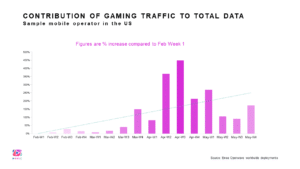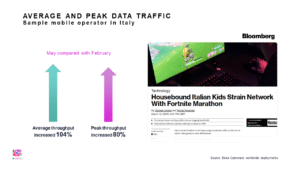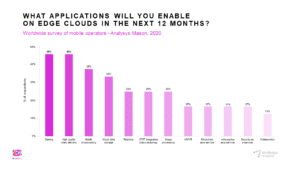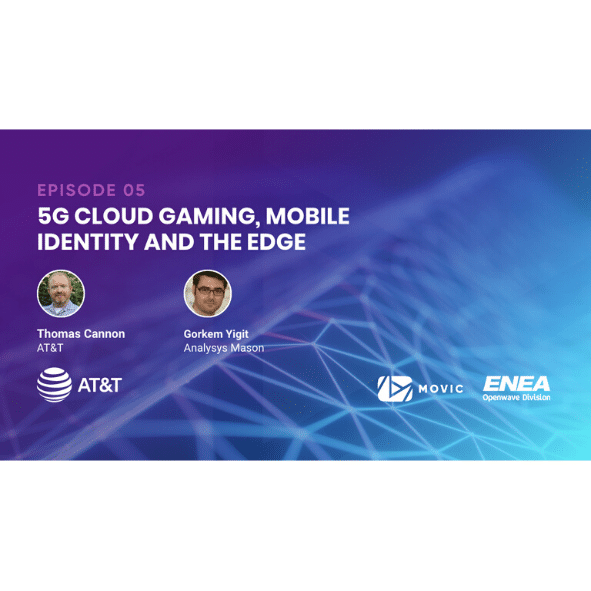Cloud Gaming, Mobile Identity & The Edge: Notes from our Microcast

Two types of latency impact mobile cloud gaming
The first point of discussion in the microcast dealt with how latency will impact mobile cloud gaming. Tom explained that there are two components of latency that impact the gaming experience. The first is end-to-end latency, or network latency, between players’ consoles or computers and the server that’s hosting the game being played. This is normally what people mean when they say “latency”.
But Tom Cannon felt that the second component -input lag – is going to become even more important as gaming systems are moved into the cloud. Input lag is the experience of pressing a button on a controller, a mouse or keyboard and then having that input registered with the computer system or console that is controlling the game. In many cases, gamers are using a wired connection in these scenarios. But as we move these gaming systems and consoles into the cloud, such as with xCloud, Stadia and Nvidia, the network latency now combines with input lag. Moving forward, solutions need to address this issue because very slow input lag will be a significant hindrance to the overall gaming experience.
Ways operators can incorporate AI/ML to address latency
The Microcast discussed how operators are working with the vendor community to use artificial intelligence and machine learning (AI/ML) to address the complex challenges created by latency and input lag. Tom explained that AI/ML create a number of approaches, architectures and methods to address latency.
From a carrier perspective, there’s a lot that can be learned from the normal use case of a gamer session, where their play style can be used to help shape traffic in such a way that the network predicts what the game needs in order to have the best gaming experience possible. From a carrier perspective, the network architecture – especially with 5G – is designed to effectively self build the network using machine learning in such a way that a path and latency profile can be built based on what the gamer is doing.
The most important expectation is that a broader sense of cooperation will be created between cloud service providers, gaming service companies and mobile carriers.
When you’re talking about self-healing, self-designing networks you have to think about a more open model that’s centered on application programming interfaces (APIs). Carriers are the transport, and they can provide a smart transport solution by exposing APIs that allow cloud service providers and gaming services to request the best possible experience for their customer from the mobile carrier. Gaming service providers are going to find that the mobile experience, especially with 5G, is going to be significantly superior to anything they have today – even with a wired connection.
Operators will play a critical role in providing a smart transport mechanism that can identify all of the different applications flowing through the network. As such, operators will be able to classify in real time mobile gaming versus video streaming. As such, there will be a high level of throughput and a low level of latency, also improving the overall gaming experience.
Stop the cheats! … With mobile identity and AI
Another key benefit that 5G brings to traditional gaming is mobile identity which stores username and password info for gamers. Put simply, it provides seamless connectivity when transitioning from one device to another, and can also prevent cheating. Tom explained that carriers have an advantage here as they are trusted connectivity providers for gamers and therefore already capable of confirming a gamer’s identity.
Verified identity is important especially to gamers. Signing onto a game can be frustrating. If you want to take your game on the go, you want to be able to move from platform to platform and device to device without having to continuously remember and type in your credentials. Tom explained that carriers have recently launched ZenKey, a joint venture that exposes customer identity in a consent-based format. With ZenKey, users have seamless sign-on capability with any mobile or wireless device service. Carriers are in the unique position of knowing customer information, including who you are, what you are, where you are and what consent you’ve provided for how your information is used.
But how does mobile identity help prevent cheating? Tom explained:
Firstly, with verified identity comes the concept of gamer reputation or gamer score. In the gaming community, many of the more popular games allow for players to effectively rate other players based on whether they believe a person is cheating. Verified identity then creates the ability to confirm whether someone is a cheater, while also giving users the ability to effectively penalize cheaters for some period of time.
Secondly, AI data analytics can also be used to detect cheating by identifying inhuman levels of capability or changes in performance that aren’t otherwise detectible. Machine learning and AI can look at the performance statistics of gamers and quickly determine whether they’re using some sort of input control or memory insertion chip to radically affect their performance. The technology automatically reports or flags them for further analysis. So watch out cheats!
Impact of Covid-19 on gaming and network traffic
Gorkem Yigit from Analsys Mason talked about how network traffic has changed since the outbreak of Covid-19. Gorkem said operator networks are being impacted by both kids and adults who are spending a great deal more time on gaming.
For example, Steam has broken its all-time record for concurrent users with a peak of more than 20 million users on the platform at the same time. This increased demand for online gaming is leading to a surge in network traffic. Verizon have said that gaming traffic has increased 75 percent. This is consistent with Enea Openwave live data from US carriers since lockdown. For example:
Telecom Italia reported that games such a Fortnite have been a major contributor to a 70% increase in internet traffic since lock down., This is also consistent with Enea Openwave data drawn from live deployments in Italy, eg:
According to Gorkem, a number of operators have committed to increasing their capex investments to enhance capacity. They are also looking at different ways to optimize their networks to get more out of them. This includes better congestion management with AI/ML, increasing planning for edge computing and looking at potential partnerships with digital providers and cloud gaming services to efficiently manage the network.
Evolution of the cloud gaming ecosystem
There was also discussion on the impending changes to the cloud gaming ecosystem, which includes cloud service providers, gaming service providers and operators. The collaboration and cooperation between the players will be crucial to the success of gaming services.
Cloud gaming is a part of many operator go-to market strategies for 5G and Analsys Mason has observed new partnerships with gaming service providers. Some of them actually go beyond commercial partnerships to technology partnerships. A good example of this is Microsoft’s partnership with Vodafone and T-Mobile for the Project xCloud, which is Microsoft’s cloud gaming service. They are testing how the cloud gaming service performs on a live mobile network with real users
Gorkem said this partnership is a win-win for operators and Microsoft, as they learn a great deal about how to deliver the best quality of experience through the partnership. Likewise, partnerships are forming between public cloud providers and operators for edge computing.
AWS Wavelength is working with operators Verizon, KDDI, SK Telecom and AT&T, as well as Microsoft Azure for the edge. There are public cloud stacks being co-located with operators to create mobile edge clouds that will run 5G network functions. There will be more collaborations over time as operators adopt more 5G network exposure capabilities with more common APIs and interfaces while they also share data assets.
Critical investment in the mobile edge
Lastly, the Microcast also looked at why operators were making substantial investments in the mobile edge.
Tom explained that mobile edge creates a number of opportunities to address lag. The idea with mobile edge is that you bring the system being played as close to the player as possible. While it’s not going to be in their living room, the goal is to bring it close to the gamer’s mobile connection or the nearest data center. At that point, latency becomes significantly lower than what we see today with larger centralized distributed and cloud gaming platforms. Doing so can significantly reduce the overall input lag delay that you have in existing architectures. Mobile edge is a key activity for AT&T, and there is similar interest from other operators to enable a better gaming experience.
Gorkem expanded on this noting that cloud gaming makes a great use case for mobile edge computing because of its high sensitivity to latency and jitter… Gorkem showed us a recent survey of operators conducted by Analysys Mason. Carriers were asked about the types of applications that they’re expecting to enable with edge clouds. The results showed that gaming is the most popular application for edge over the next 12 months.
Half of the respondents picked gaming delivery as their top driver for edge deployments, showing that edge computing will be a key component of operators for 5G revenues and service strategies.
Register for our Microcasts
Our short 15-minute videos bring together thought leaders and commentators to look at a range of mobile operator challenges and market opportunities.
In case you missed the previous microcasts…
- ABI Research, Tutela and Root Metrics looked at operator benchmarking – you can watch it here
- Wired magazine and Analsys Mason examined the impact and potential of cloud gaming on 5G mobile network – watch it here
- ABI Research and Strategy Analytics discussed how mobile operators in Europe, Asia and the Americas were managing their networks during the Covid-19 lockdowns – watch it here and read the bonus material here.
- Telefonica and Strategy Analytics discussed 5G deployment and data management in a changing world – watch it here






